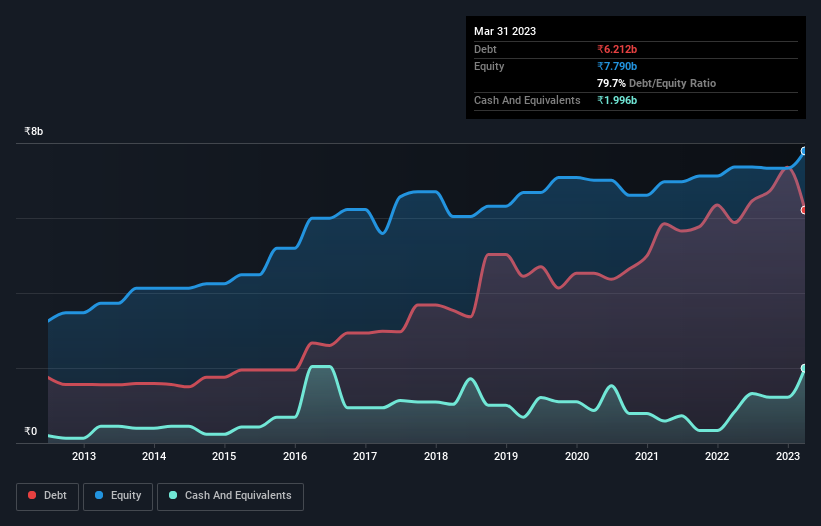- India
- /
- Metals and Mining
- /
- NSEI:PENIND
Pennar Industries (NSE:PENIND) Has A Pretty Healthy Balance Sheet

Warren Buffett famously said, 'Volatility is far from synonymous with risk.' When we think about how risky a company is, we always like to look at its use of debt, since debt overload can lead to ruin. We note that Pennar Industries Limited (NSE:PENIND) does have debt on its balance sheet. But the real question is whether this debt is making the company risky.
When Is Debt Dangerous?
Debt is a tool to help businesses grow, but if a business is incapable of paying off its lenders, then it exists at their mercy. Part and parcel of capitalism is the process of 'creative destruction' where failed businesses are mercilessly liquidated by their bankers. However, a more common (but still painful) scenario is that it has to raise new equity capital at a low price, thus permanently diluting shareholders. By replacing dilution, though, debt can be an extremely good tool for businesses that need capital to invest in growth at high rates of return. When we think about a company's use of debt, we first look at cash and debt together.
See our latest analysis for Pennar Industries
How Much Debt Does Pennar Industries Carry?
As you can see below, at the end of March 2023, Pennar Industries had ₹6.21b of debt, up from ₹5.88b a year ago. Click the image for more detail. However, it also had ₹2.00b in cash, and so its net debt is ₹4.22b.

A Look At Pennar Industries' Liabilities
We can see from the most recent balance sheet that Pennar Industries had liabilities of ₹13.7b falling due within a year, and liabilities of ₹1.70b due beyond that. Offsetting this, it had ₹2.00b in cash and ₹3.63b in receivables that were due within 12 months. So its liabilities total ₹9.76b more than the combination of its cash and short-term receivables.
This is a mountain of leverage relative to its market capitalization of ₹10.4b. This suggests shareholders would be heavily diluted if the company needed to shore up its balance sheet in a hurry.
We measure a company's debt load relative to its earnings power by looking at its net debt divided by its earnings before interest, tax, depreciation, and amortization (EBITDA) and by calculating how easily its earnings before interest and tax (EBIT) cover its interest expense (interest cover). This way, we consider both the absolute quantum of the debt, as well as the interest rates paid on it.
While Pennar Industries has a quite reasonable net debt to EBITDA multiple of 1.9, its interest cover seems weak, at 1.7. This does suggest the company is paying fairly high interest rates. Either way there's no doubt the stock is using meaningful leverage. It is well worth noting that Pennar Industries's EBIT shot up like bamboo after rain, gaining 31% in the last twelve months. That'll make it easier to manage its debt. When analysing debt levels, the balance sheet is the obvious place to start. But it is future earnings, more than anything, that will determine Pennar Industries's ability to maintain a healthy balance sheet going forward. So if you want to see what the professionals think, you might find this free report on analyst profit forecasts to be interesting.
Finally, a business needs free cash flow to pay off debt; accounting profits just don't cut it. So the logical step is to look at the proportion of that EBIT that is matched by actual free cash flow. During the last three years, Pennar Industries produced sturdy free cash flow equating to 66% of its EBIT, about what we'd expect. This cold hard cash means it can reduce its debt when it wants to.
Our View
When it comes to the balance sheet, the standout positive for Pennar Industries was the fact that it seems able to grow its EBIT confidently. But the other factors we noted above weren't so encouraging. In particular, interest cover gives us cold feet. When we consider all the factors mentioned above, we do feel a bit cautious about Pennar Industries's use of debt. While we appreciate debt can enhance returns on equity, we'd suggest that shareholders keep close watch on its debt levels, lest they increase. When analysing debt levels, the balance sheet is the obvious place to start. However, not all investment risk resides within the balance sheet - far from it. For example, we've discovered 3 warning signs for Pennar Industries (1 doesn't sit too well with us!) that you should be aware of before investing here.
Of course, if you're the type of investor who prefers buying stocks without the burden of debt, then don't hesitate to discover our exclusive list of net cash growth stocks, today.
New: Manage All Your Stock Portfolios in One Place
We've created the ultimate portfolio companion for stock investors, and it's free.
• Connect an unlimited number of Portfolios and see your total in one currency
• Be alerted to new Warning Signs or Risks via email or mobile
• Track the Fair Value of your stocks
Have feedback on this article? Concerned about the content? Get in touch with us directly. Alternatively, email editorial-team (at) simplywallst.com.
This article by Simply Wall St is general in nature. We provide commentary based on historical data and analyst forecasts only using an unbiased methodology and our articles are not intended to be financial advice. It does not constitute a recommendation to buy or sell any stock, and does not take account of your objectives, or your financial situation. We aim to bring you long-term focused analysis driven by fundamental data. Note that our analysis may not factor in the latest price-sensitive company announcements or qualitative material. Simply Wall St has no position in any stocks mentioned.
About NSEI:PENIND
Pennar Industries
Operates as an engineering company in India and internationally.
Reasonable growth potential with proven track record.

